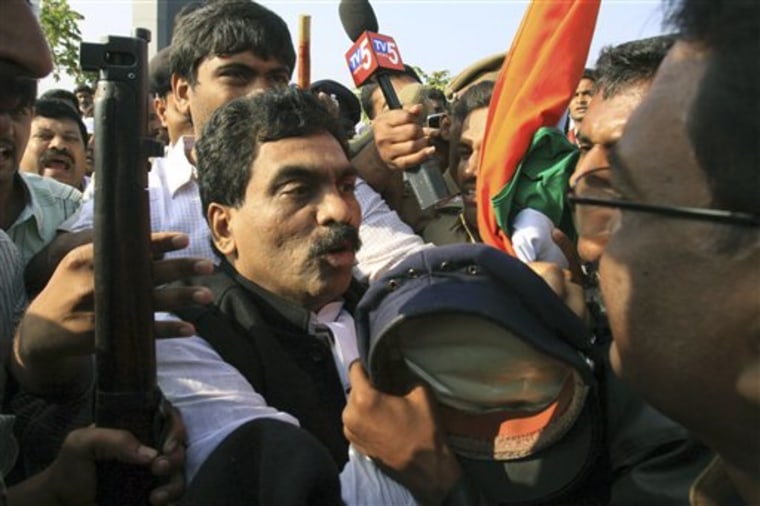From scores fasting in demand of a new state in India’s hilly northeast to a powerful chief minister suggesting her region be split up, the map of the nation is facing an overhaul.
Ethnic minorities and activists in economically deprived regions are seeking states of their own, following the government’s surprise decision last week to give in to a hunger strike and create a new state in southern India.
Now, India is confronting serious calls for a grand reorganization of this sprawling, diverse nation of 1.2 billion.
“We are looking at what could be a major crossroads in the political evolution of the Indian system,” said Mahesh Rangarajan, a prominent political analyst at Delhi University. “Are 28 states enough for a billion people when 300 million Americans have 50 states?”
China, which India is expected to surpass in 2025 as the world’s most populous country, uses centralized, authoritarian rule to maintain order and unity. India’s democracy has relied on constant negotiation and compromise to empower its different ethnic groups and bind the diverse country, from the rural hill people who live on the Tibetan border to the business tycoons of Mumbai.
Organized around language
The Indian system gives broad power to the states. It was largely created after a Gandhi disciple died from a 58-day hunger strike in 1952, while pressing for the creation of Andhra Pradesh, a new state in the south.
Following the ensuing street protests, the government agreed to reorganize the country based on language groups. India has occasionally tweaked its internal boundaries since then, most recently with the creation of three new states in 2000 that brought the total to 28.
Some states remain so large they have become difficult to govern, leaving politically marginalized regions out of the country’s economic boom.
“You’ve got to try something new,” Rangarajan said. “Something’s not working about it.”
Parties across the spectrum — including the ruling Congress Party — have backed appeals for new states to garner regional support during elections. But as the campaigns fade, so does the pressure for statehood.
In an attempt to re-ignite the passions, politician K. Chandrasekhar Rao embarked on another hunger strike in Andhra Pradesh last month, demanding his neglected region of Telangana be given statehood.
As his health faded and protests grew, the government suddenly gave in — and was immediately swamped by calls for at least 16 other new states.
Large versus small
Some want states for neglected minorities, such as the 105 ethnic Gurkha activists who have been fasting since Friday, calling for a state of Gorkhaland to be carved out of West Bengal.
“This is our final battle,” said Bimal Gurung, a leader of the Gurkha movement. “If the Telangana demand can be met, why can’t our 102-year-old demand be met?”
Others are seeking development of poor and neglected areas, such as the interior Vidarbha region in the state of Maharashtra, which many argue has been ignored in favor of the coastal areas around Mumbai.
Some say smaller units will be more manageable and responsive to voters and lead to better governance.
Mayawati, the powerful chief minister of Uttar Pradesh, sent a letter last week to Prime Minister Manmohan Singh calling for her gargantuan state to be split in four pieces so it can be more easily administered. The state’s 180 million people give it a population larger than all but five countries in the world.
“This is the demand of the people and the central government should respect people’s sentiments,” she said.
Mayawati, who uses only one name, appeared to be making a shrewd calculation. If the Congress Party government rejects her proposal, it will alienate voters; if it grants it, it will give her regional party three more states — with their accompanying sources of patronage — to potentially govern.
“She is trying to play to the rallies and create some trouble for the government of India to score some political points,” Congress spokesman Shakeel Ahmed said.
She also has a point, analysts say. Bringing politicians closer to the voters is healthy for democracy.
“If your state’s capital is 100 miles away instead of 400 miles away, in theory they are more obliged to listen to you,” said Ramachandra Guha, a prominent historian and author of “India after Gandhi.”
“We are an evolving nation, we are 60 years young. We are yet to find the correct political forms to cope with our growing population,” he said.
More states to come?
Calls are growing for the government to appoint a reorganization commission to take a look at the structure of the country, give a platform for all the statehood activists to air their demands and decide what new states are needed.
Reflecting the political sensitivity of the issue, Congress spokesman Ahmed said the party would not oppose such a commission “provided there is a consensus.”
There are dangers in giving too much, as well.
The Telangana decision has sparked fierce counterprotests in Andhra Pradesh by residents of the state capital, who fear their city might wind up belonging to a different state.
The government has tried to tamp down expectations.
Finance Minister Pranab Mukherjee warned that the Telangana decision “does not mean new states are going to be created everywhere.”
But the newly energized activists say they will not go away.
“Up until now, Andhra Pradesh was boiling,” said Raja Bundela, a leader of the fight for a Bundelkhand state. “It could be Bundelkhand’s turn to burn next.”
